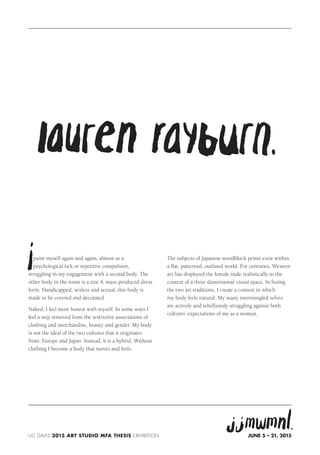The document discusses an art exhibition titled "jjmwmnl." held at UC Davis in 2015. It features works by 7 Master of Fine Arts students from the UC Davis Art Studio program. The artists use a variety of media like painting, sculpture, drawing and time-based works to create pieces that encourage reflection on everyday life and blur boundaries. Their experimental processes produce works dealing with issues of violence, the environment and identity. The exhibition provides an opportunity to experience different artistic practices and the experimental spirit of the student artists.
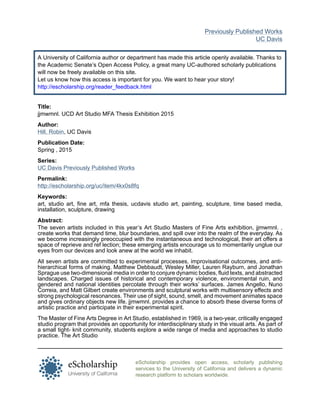
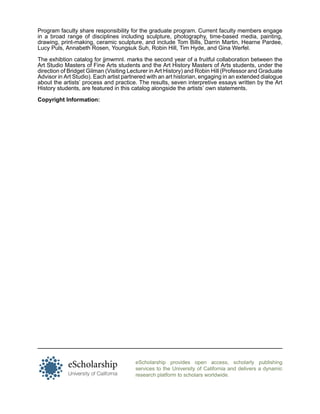
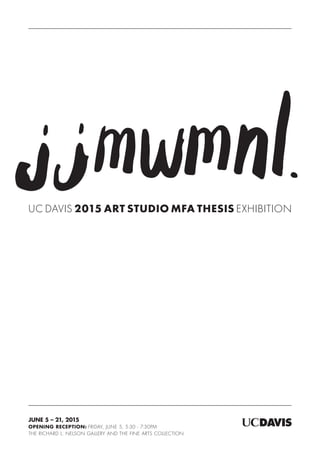












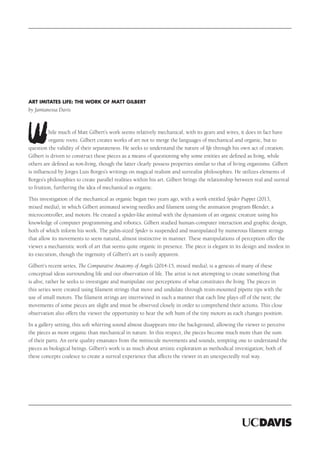











![uno Correia’s work doesn’t break boundaries, it dispels them. Talking casually in his studio, he muses that for
many artists, artistic inquiry is about goals: “I’m going to make a sculpture… I’m gonna make this object. But
after you make so many of those, you realize it’s not satisfying.” Correia’s vision takes on a dramatic range of material
expressions, from spare furniture-and-sawdust installations to equally cryptic video showing soundless footage
of driving California’s highways. These perhaps esoteric images can leave the audience with more questions than
answers—but then, the same is true of Correia’s process, a circumnavigatory meditation in which “the questions… are
the answers, that become more questions.”
The spartan quality of these installations is no accident. Correia often describes his work as materially stripped down,
including only visual essentials. “Whether I’m doing live installations, moving geometric forms… it’s always about
trying to resolve some fundamental issue.” When pressed, he continues, “Why is [art] different from everything else?
…It’ll be steel I-beams on the back of a truck… and I see it as a sculpture in a gallery.”
Though Correia’s work resists alignment with a singular art historical tradition, his emphasis on process echo es
the traditions of Dada, Happenings, and Fluxus. Like these movements, Correia’s work dismantles hierarchies
within art and object making. He recalls, “There’s a photograph of the time Chris Burden got shot in the arm…
What you’re looking at is the process that resulted in that object… I see the sawdust square and the chair in the
same way, as a recording of a performance.” Although aspects of Correia’s process are fundamentally accidental,
the practicalities of building the furniture and sifting the sawdust onto the floor involve deliberate rigor, and a
trancelike focus associated with master craft.
This material process arises from a conceptual framework neither wholly spontaneous nor rigidly static. Rather, his
furniture and installations arise contemplatively, discovering the unconscious conceptual by tuning out conscious
practice through physical repetition. Considering without considering, thinking without thinking, the stereotypical
Zen question about one hand clapping: Correia’s work happens in the making of, and only then. “The sawdust is
doing what it does best, and I just facilitate that.” The chair in the sawdust is always now, temporally arrested—it
lends its audience no clues about possible pasts or futures. It would be impossible to make the meticulous sawdust
squares quickly, and it is partly this arduous process that lends the finished product a stillness and fragility with an
undeniably magnetic draw.
The artist’s works can be considered in strictly formal terms, but the installation’s power lies with the meditatively
cyclical quality of material as process, process as material. Correia notes that “the only way to understand it is to sit
with the work”—to lend it your disciplined concentration. If you do so, “… After a while, you get to that point—you
get lost in it. That’s one of the important things about this process—the getting lost.”
Getting Lost
by Hannah Kagan-Moore](https://image.slidesharecdn.com/82a0ec43-bc54-4931-ac9a-3efb8df43d65-160216191522/85/jjmwmnl-28-320.jpg)
